One could easily make the case that Serie B is the most competitive league in Europe right now. Just ten points divide first and eighth place in the table.
Eight teams are battling it out to reach the promised land, top-flight football in Italy, but just three can make it. With seven games remaining in the league campaign, the boys will be separated from the men and the coaches will really be forced to earn their coin.
This season, Serie B has truly highlighted why so many immerse themselves in the beautiful game. Preposterous highs, and gut-crushing lows as part of an infectious ten-month long epic. But what is a great tale without an inspiring underdog story?
U.S. Cremonese are this season’s David, smiting every Goliath that dares to step into their path and halt their devilish quest for promotion to Serie A for the first time since 1996.
Fabio Pecchia is the man leading the charge. Appointed to the dugout in January 2021, the former assistant of Rafael Benitez at Napoli, Real Madrid and Newcastle United is defying the odds with the Grigiorossi. Cremonese finished in thirteenth last season. Now, they sit on the throne at the summit of the table, albeit an insecure one.
This article will be a tactical analysis of Serie B’s surprise package this season in the form of a team scout report. It will be an analysis of the side’s tactics under Pecchia, observing their structure in and out of possession.
Formation and squad profile
In true discipleship towards Benitez, Pecchia’s go-to formation this season has been the 4-2-3-1. It has been used in 38 percent of the team’s games. This conventional structure gives the perfect balance for any side in the attacking phases as well as defensively.
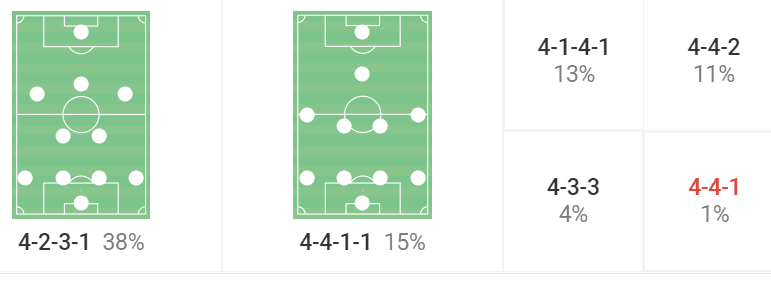
This is perhaps the best way to describe the league leaders in their current state: perfectly balanced, one of the best compliments any side can receive in football.
Nevertheless, the Italian underdogs are certainly no stranger to other tactical formations. They often deploy the 4-4-1-1, as well as 4-1-4-1 and a 4-3-3. Even the classic 4-4-2 has gotten a look in quite a bit. Changing formations regularly can cause a lot of sides to struggle for fluidity in games due to having to perform different roles in each set-up.
However, Pecchia’s team are incredibly flexible tactically and not just with their choice of system from game to game. Their style is also malleable depending on the opposition on the day. Looking at the possession statistics for Serie B, the Grigiorossi have one of the lowest percentages this season so far with 48.7 percent.
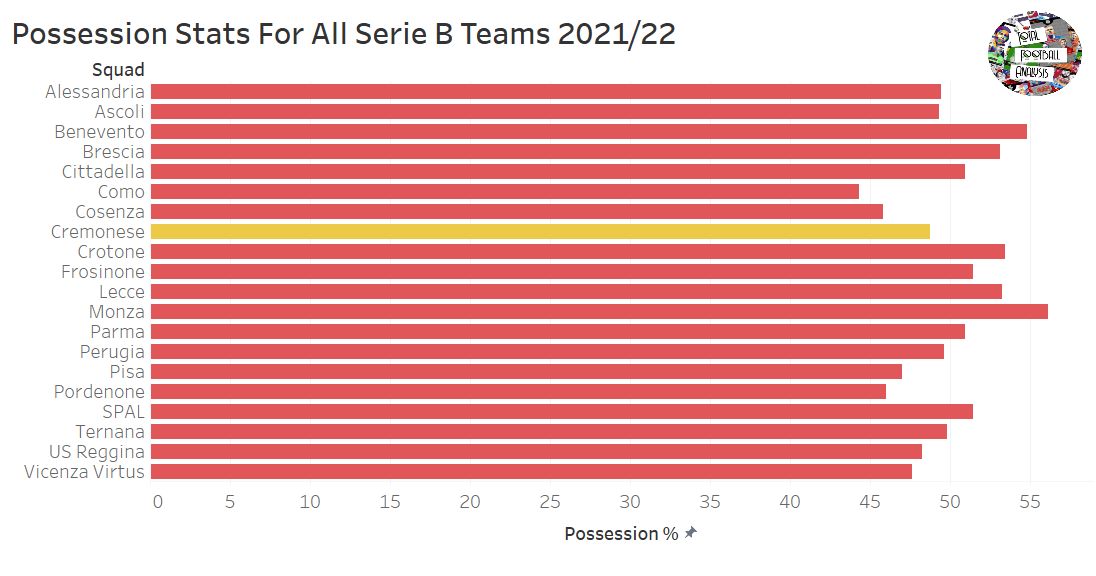
This certainly doesn’t imply that Cremonese are a defensive side but simply that they are comfortable out of possession just as much as in it, hence why they have been so consistent throughout the campaign as their style of play suits all opponents. Not to bang this same drum again, but tactical and stylistic flexibility are both very visible traits in any Benitez team.
What’s most interesting about Cremonese though is the profile of their squad. In the summer as well as winter transfer windows, the club made some solid signings, bringing in multiple highly-rated young players on loan, including attacker Gialuca Gaetano from Napoli, midfielder Nicolo Fagioli and winger Luca Zanimacchia from Juventus, centre-back Caleb Okoli from Atalanta and even left-back Leonardo Sernicola from Sassuolo. Fagioli, Gaetano and Zanimacchia have 15 assists between the three of them.
Cremonese also made some astute permanent purchases, nabbing Dennis Politic from Bolton Wanderers and even Luca Ravanelli, the son of Italian legend Fabrizio Ravanelli, from Sassuolo too.
The squad’s average age now is quite young, making Pecchia’s work even more impressive, but the team is still doused with some immense experience such as 36-year-old star striker, captain, and top goalscorer Daniel Ciofani. Compared to the rest of Italy’s second tier, Cremonese have one of the youngest squads with an average age of 25.6.
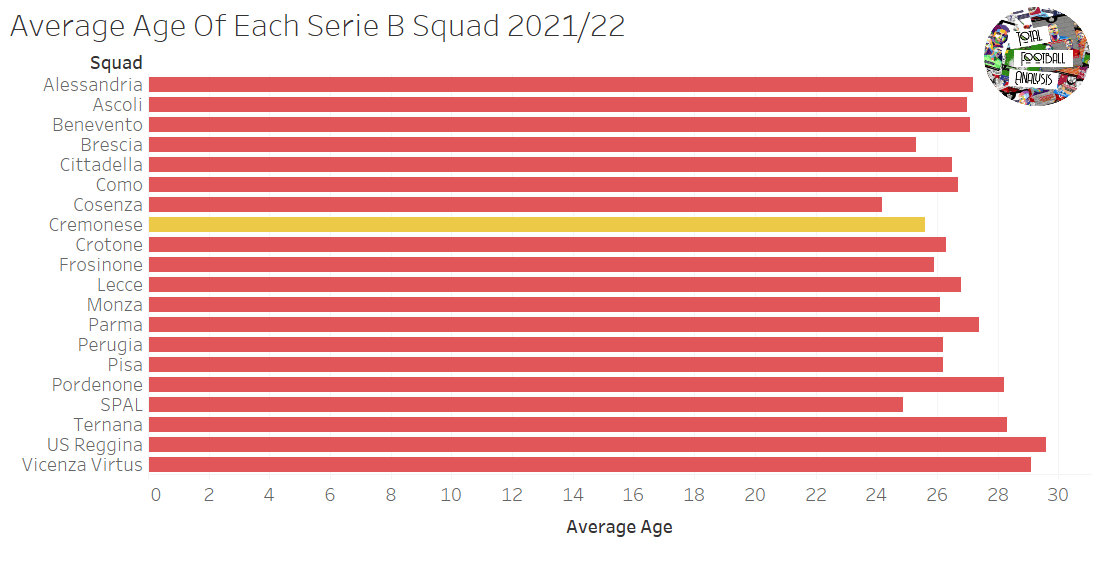
The squad is perfectly crafted like an eloquent mostardo cremonese, a condiment comprised of candied fruit drizzled in mustard-flavoured syrup, originating in the Cremona region. It sounds absolutely ghastly but yet would quench the appetite of anyone with a sweet tooth, like Pecchia’s side.
Possession in deep areas
Especially against lesser opposition, Cremonese do try and build their way from the goalkeeper to the final third. In the first phase, the centre-backs split wide while the fullbacks push higher.
The double-pivot sit behind the opponent’s first line of pressure, screening the centre-forwards while trying to create a passing angle to receive the ball in order to progress play.
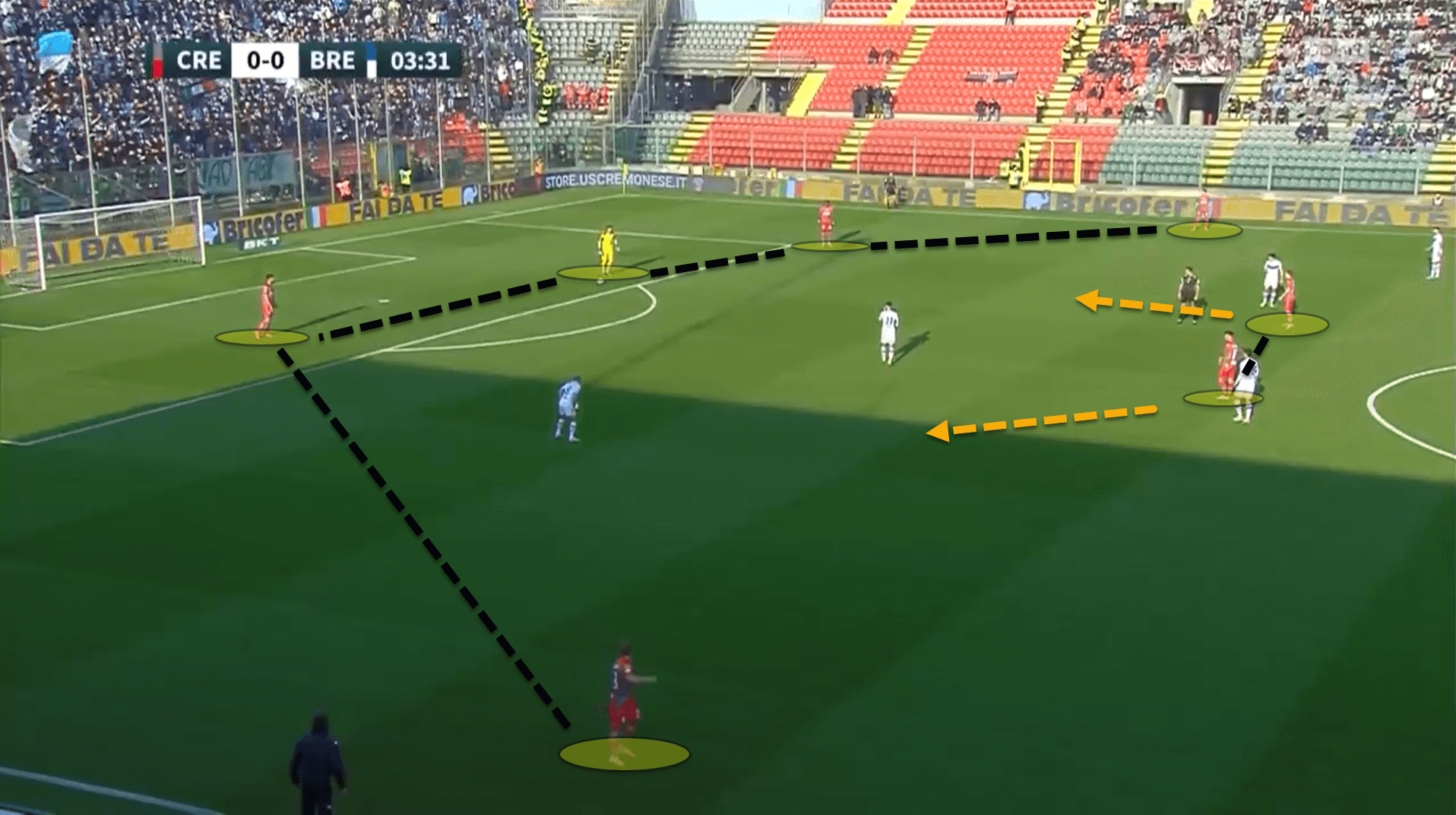
Cremonese are quite intelligent with their positional structure in these areas. This is because the front four stay very high and wide up the pitch, pinning the opponent’s backline, particularly the fullbacks.
This is important. Generally, when a team drops over to one side of the pitch to press, the ball-far defending fullback will be ready to pounce on his opposite number if the ball is switched.
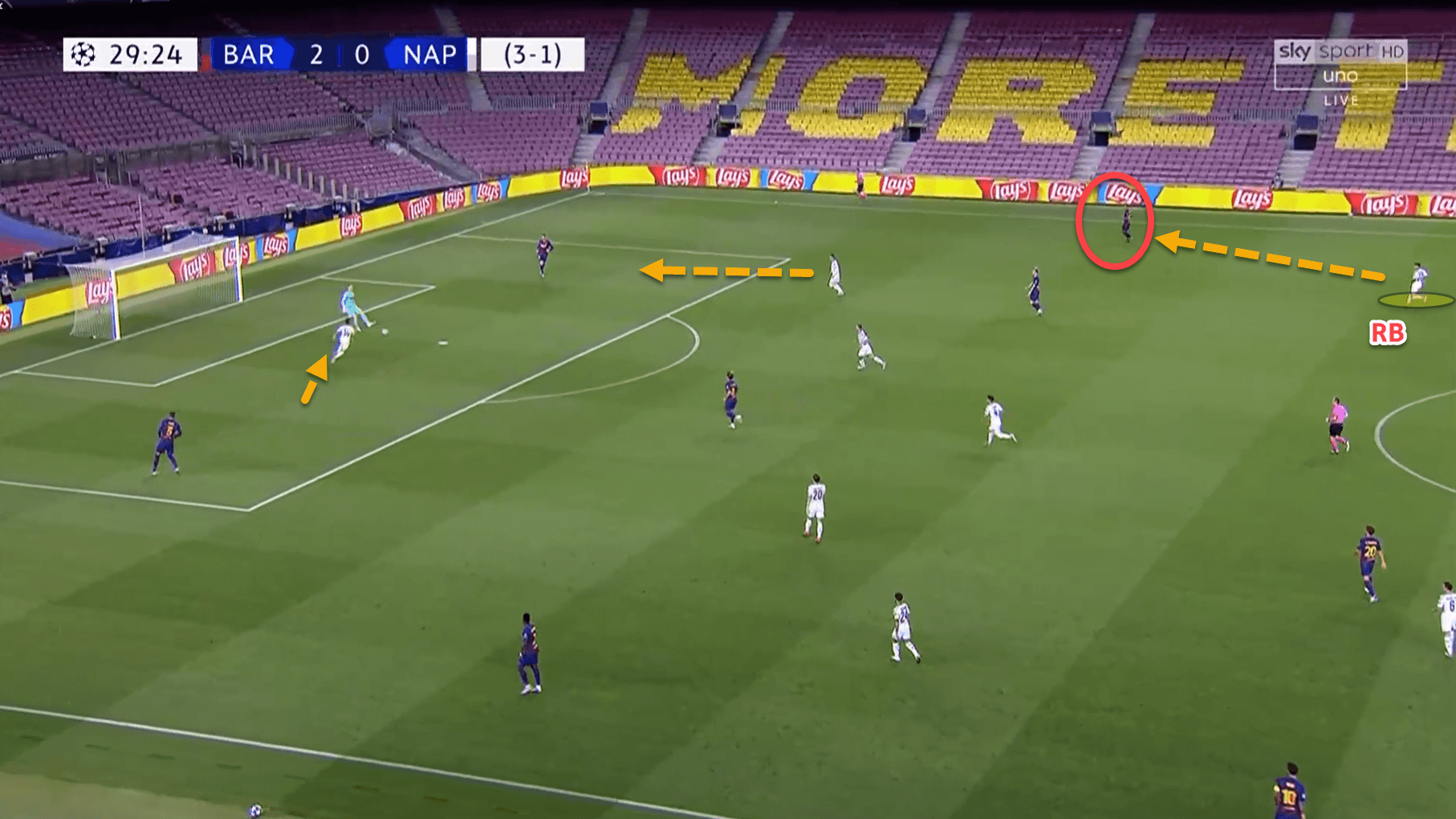
For instance, here, Napoli are pressing very narrowly against Barcelona in the UEFA Champions League back in 2020. This has caused La Blaugrana’s left-back to be free to receive on the far side should the players switch the play.
However, Napoli’s right-back is shifting across already in anticipation of the switch, allowing him to strike at a moment’s notice.
By Cremonese pinning the fullbacks down alongside the centre-backs, it allows them to play the ball out to the fullbacks while playing out. This is a constant tactical component of the Grigiorossi’s play.
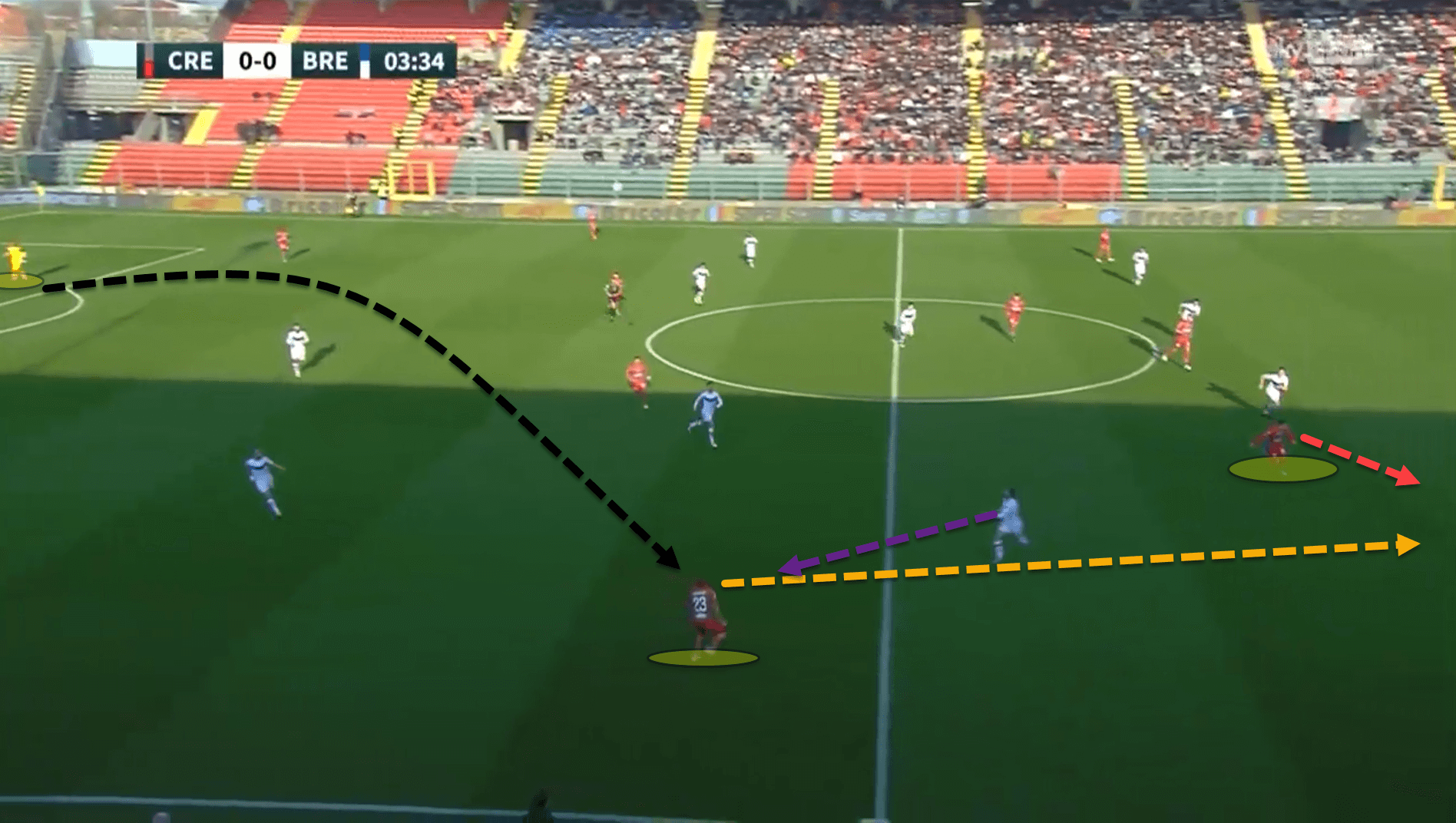
This is an example where playing to the free fullback worked perfectly for Cremonese. The goalkeeper lobbed it to the right-back. Noticing that the player is free to receive, his opposite number steps out to challenge him aerially but this allows the winger, who was pinning Brescia’s left-back and left central defender, to run in behind in the channel.
The right-back nodded it into his path and then Cremonese were allowed to attack in a dangerous area of the pitch. This all came from merely some good positioning against the opponent’s block and has proven to be a legitimate way for the Serie B leaders to bypass pressure and advance up the pitch quickly.
Cremonese tend not to dilly-dally in possession. The team boast a passing rate of 12.8 which is still rather high but is currently one of the lowest in the division right now. Passing rate measures how many passes a team makes per minute of possession.
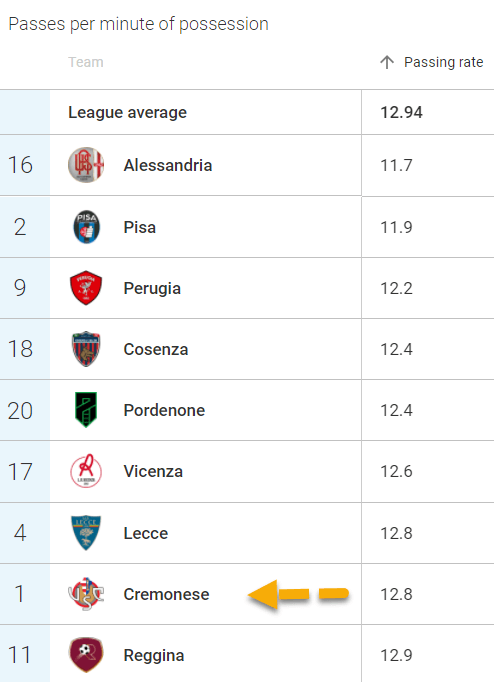
While having possession in deeper areas, so not to become monotonous and predictable, Pecchia likes his side to switch things up. Quite often, Cremonese will go long from the goalkeeper or the central defenders.
Having massive target men such as Ciofani helps this, of course. The skipper is 6’4 and weighs roughly 82kg, according to Wyscout. His physique is overpowering, and the Italian is a handful for any defender in the air as well as when he has his back turned to goal.
Once the ball is hit long to the gargantuan, players support in front of him in case it’s knocked down, while at least one attacks the space behind.
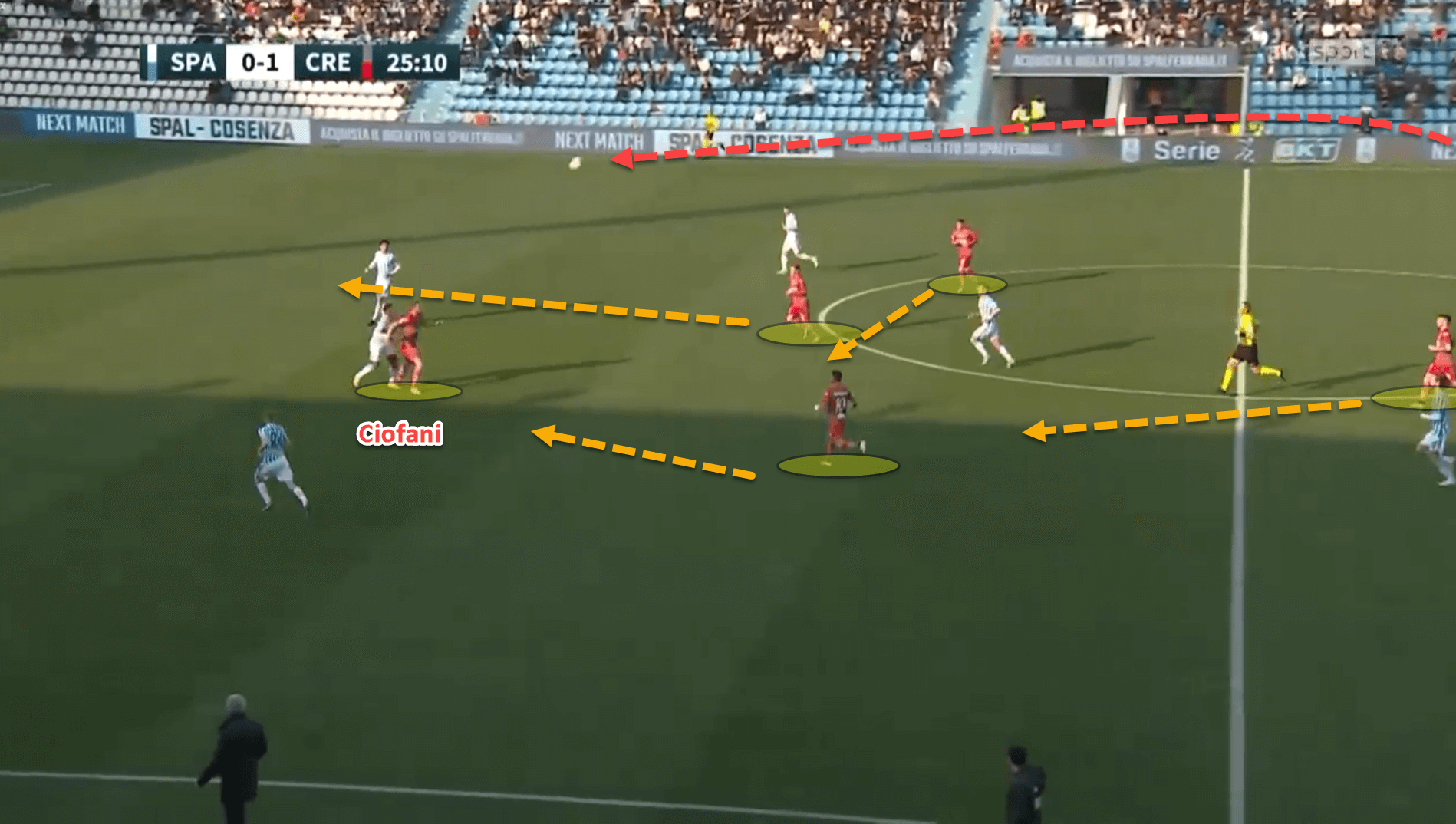
Cremonese can play out from the back using short passes, but they can also go direct, especially against better opposition or teams who press high. Once again, their flexible tactical approach has worked wonders this season and makes them extremely adaptive.
Wide overloads
For sides who are more cautious with their approach in possession, attacking down the flanks and creating wide overloads is the perfect way to inflict damage on an opponent while ensuring that the defensive balance isn’t skewed in case of a turnover of possession.
Cremonese are one of these more pragmatic teams under the guidance of Pecchia. The Grigiorossi always look to create overloads out wide. This is often triggered by one of the pivot players dropping beside the central defenders to create a back three which allows the fullbacks to advance.
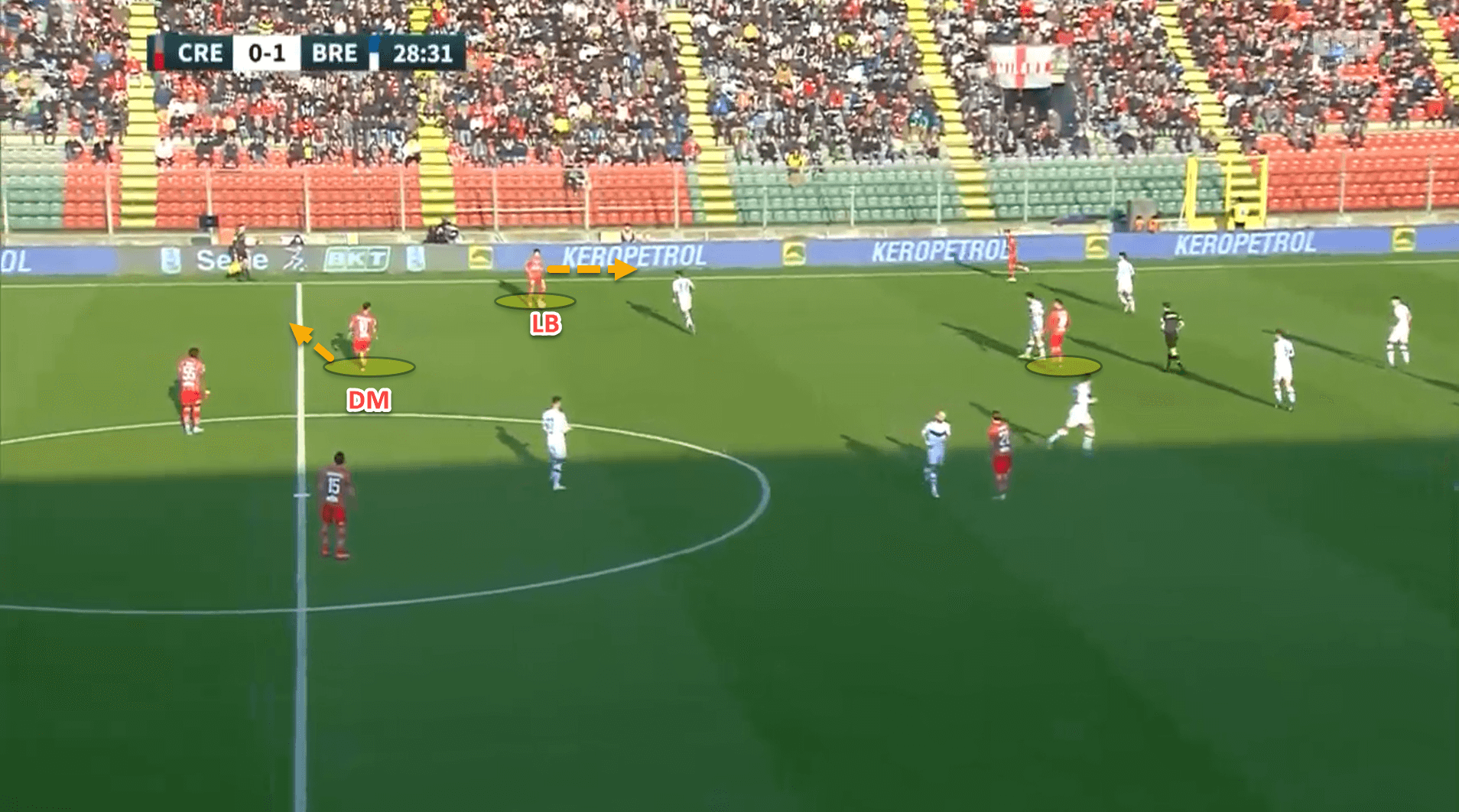
In this scenario, the holding midfielder dropped out beside the left centre-back. This facilitated the left-back to push higher on the wing while having a number ‘6’ dictating play behind them.
These wide overloads are extremely effective for teams that can create solid combination play down the sides. In Cremonese’s case, they are stacked for wingers and rely heavily on them as well as their fullbacks for crosses in towards the box.
Jaime Baez, Zanimacchia, Cristian Bounaiuto, and Hamza Rafia all rotate on the wings but are incredibly talented wide-men capable of beating their man and putting decent balls in towards the colossal Ciofani.
Cremonese have a tendency to attack down the right in most of their matches too. This is the side that Pecchia deploys Zanimacchia and the young Italian forward is relied on heavily to create chances from here, bagging five assists across the entire campaign.
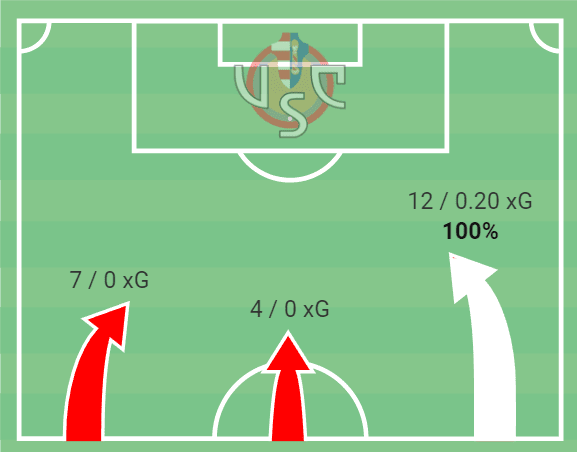
This data viz displays all 23 of Cremonese’s positional attacks from their most recent outing against SPAL in a 2-0 victory away from home. 12 were down the right, which is more than half. Zanimacchia began on this side and even bagged himself a goal.
The Juventus loanee’s influence is even apparent in the Grigiorossi’s pass maps. The following visual portrays the team’s passing network from the same match.
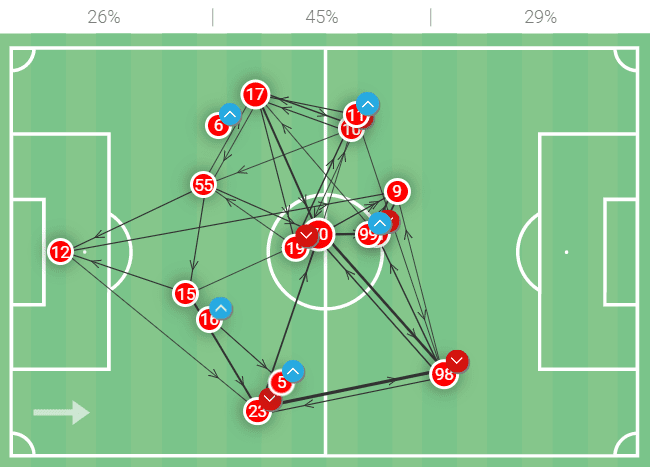
What is incredibly noticeable is that, for the most part, the passing links between the players are quite weak. The strongest were from the right-back to Zanimacchia and one of the pivot players to Zanimacchia.
Linking up with the right-back during a wide overload, Zanimacchia is constantly able to get into dangerous positions to cross the ball into the box.
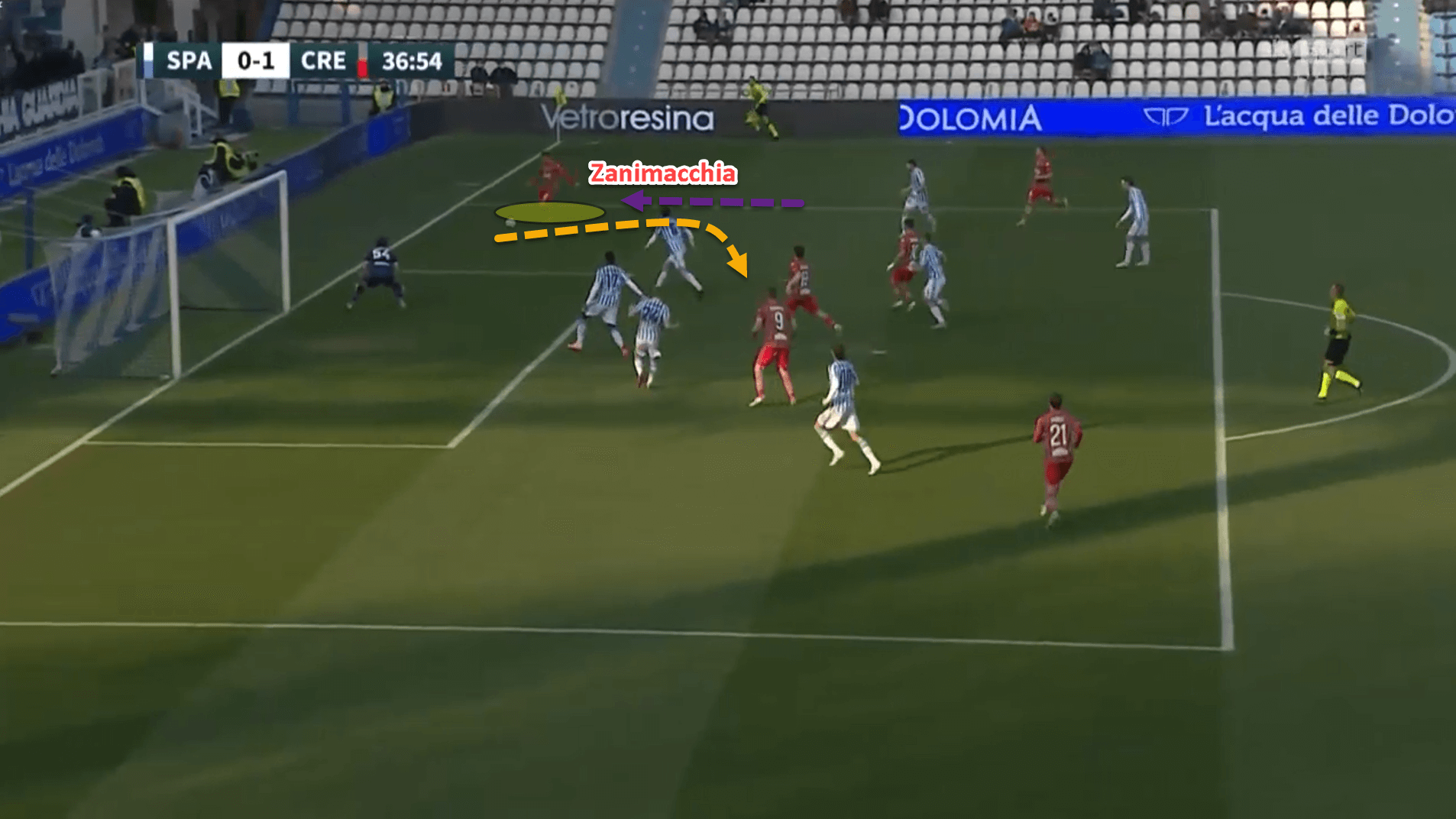
Wide overloads allow teams to break through opposition defensive blocks using numerical superiority. However, they can also be seen as defensive manoeuvres as when possession is lost, the team can quickly counterpress with numbers to regain possession, using the touchline as an extra defender.
It is much more difficult for a side to defend a transition in the middle of the park as the opponent has the entire field to play in. Whereas out on the flanks, their options are curtailed significantly.
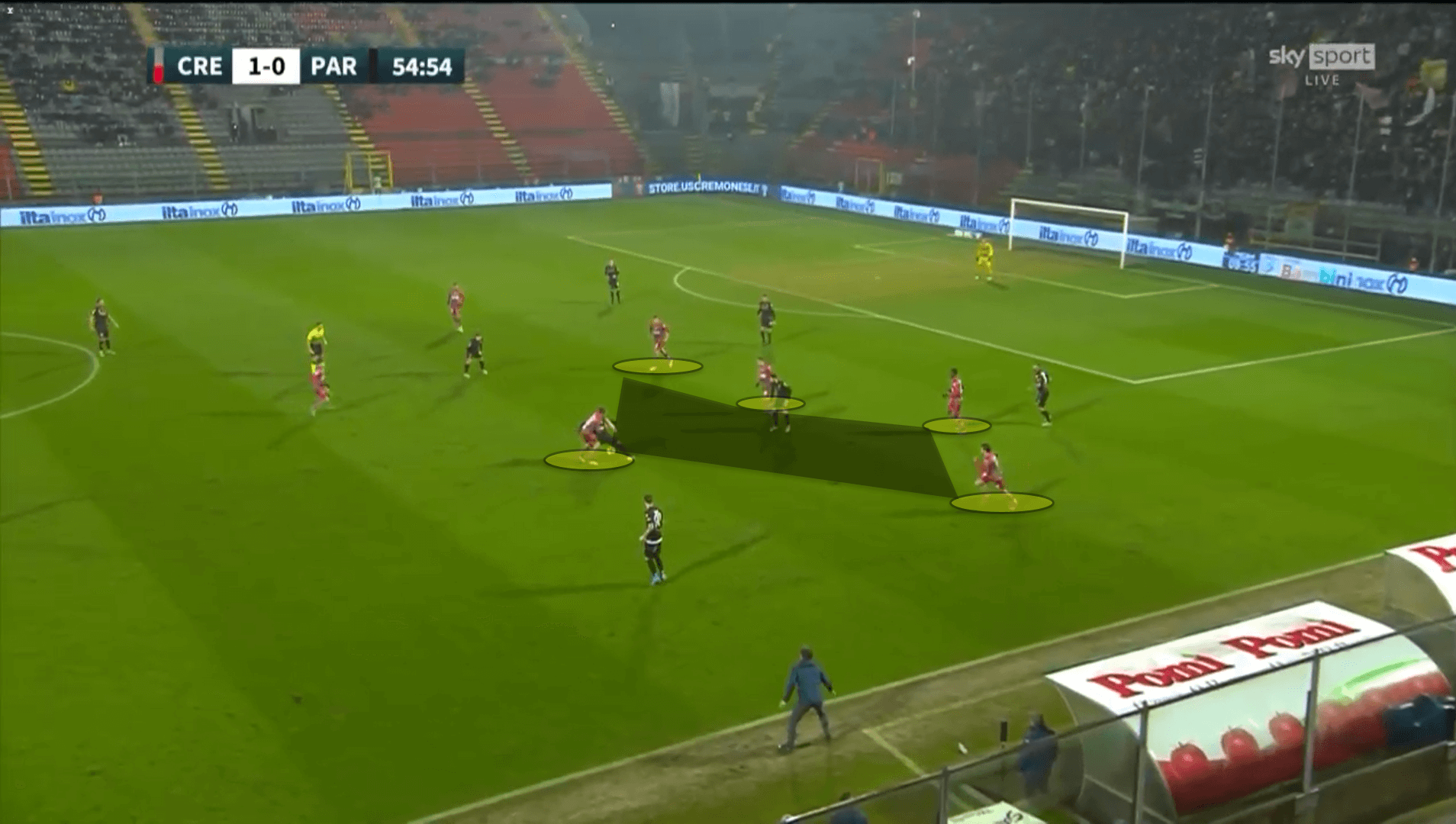
This is a persistent tactic employed by Pecchia, allowing his side to be dangerous going forward but still secure when possession is lost. This is more commonly known in the analytical community as having a good rest defence structure.
Cautious pressing and deeper defending
Cremonese do press high at times but there’s no emphasis from the coaching staff to be as tenacious with it as a side like Liverpool or Leeds United. The Italian league leaders have a preference for dropping off into a mid-level defensive block and remaining compact.
When looking at all of the clubs’ Passes allowed Per Defensive Action and challenge intensity metrics in Serie B, Cremonese perform quite averagely.
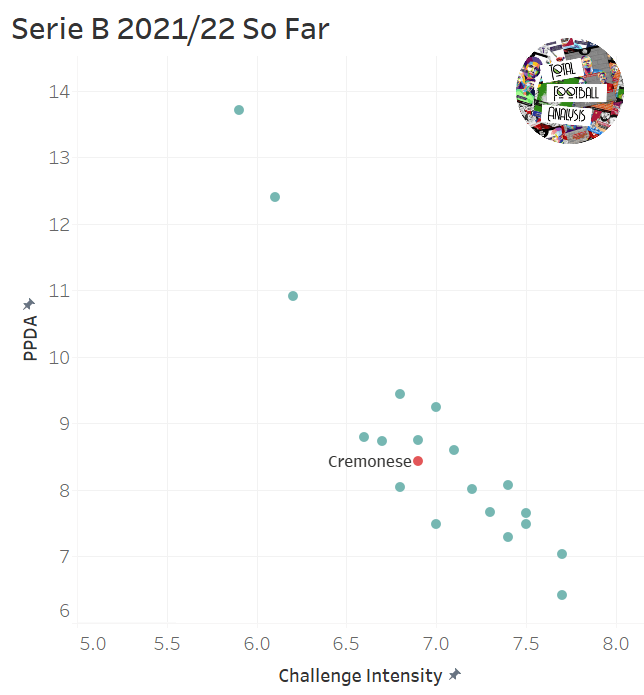
The lower the PPDA, the less time a side allows their opponent to have on the ball. Pecchia’s potential champions currently have one of the highest PPDAs in Serie B with 8.43. Nevertheless, they also boast one of the highest challenge intensity numbers in the league at 6.9 which takes into consideration the number of defensive actions made per minute of opposition possession.
Basically, Cremonese tend not to press too high but hit hard when they do apply pressure to the ball.
Given that their starting shape is generally a 4-2-3-1 or a variation of it, out of possession, this drops into more of a 4-4-2 in a medium or low-level block.
The team are extremely well-drilled and constantly shifting back and forth in unison to cover the width of the pitch without breaking their shape. This is truly emblematic of the wonderful work being done on the training field.
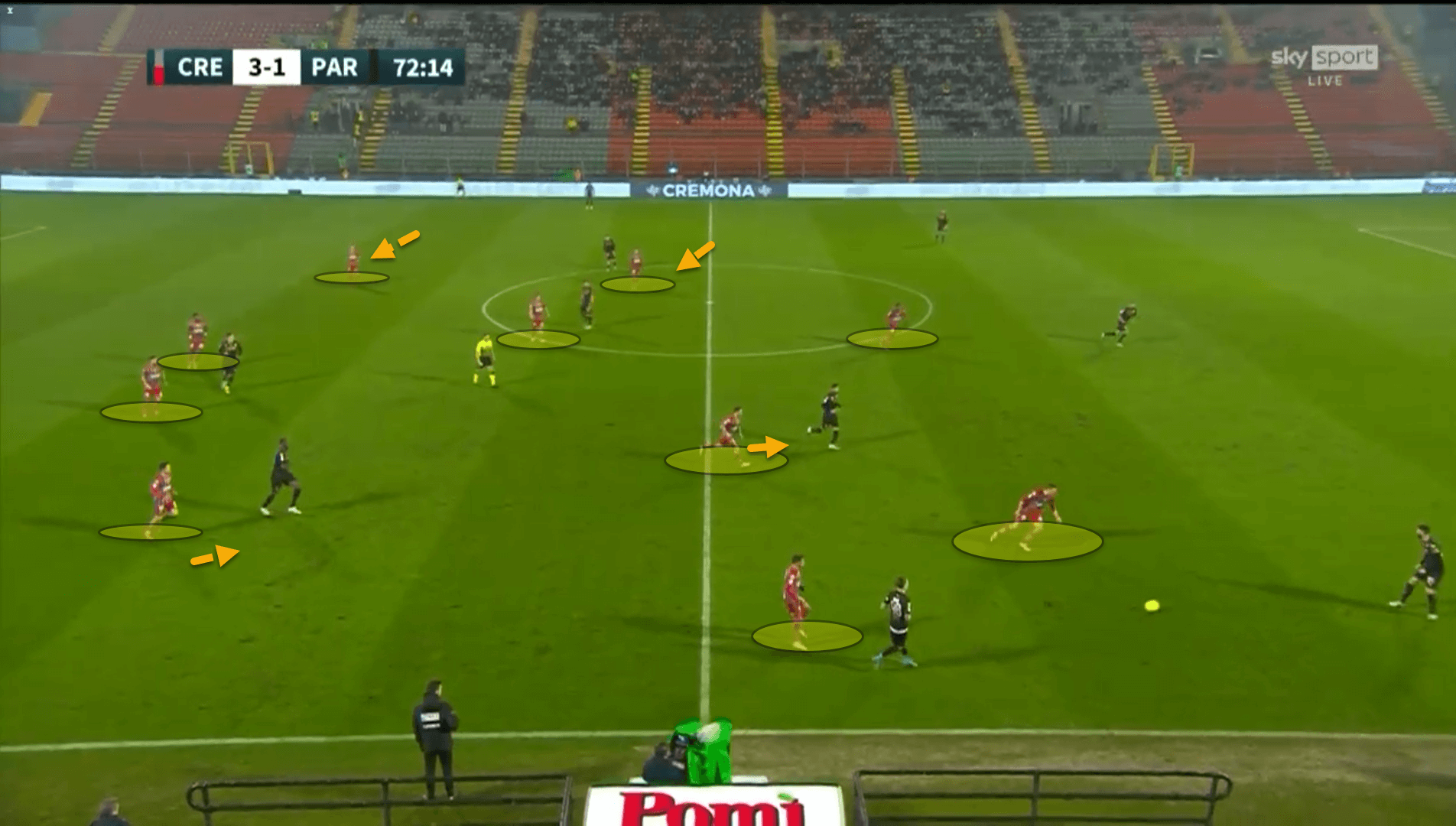
The most noticeable aspect of Cremonese’s defensive structure is their compactness. Rafa Benitez’s favourite word was ‘compact’, according to esteemed pundit Jamie Carragher, and the Spaniard’s methods have seemingly rubbed off on Pecchia.
As can be seen from the previous image, even in the 73rd minute of play, the Serie B table-toppers are keeping it very tight between the lines and are drifting across to defend the wide areas as a united contingent.
Cremonese look to regain possession in these wide spaces. Much like their counterpressing, having the side-lines to help is a wonderful tool when defending as it limits the passing options the player in possession has.
Force the opponent wide and applying pressure aggressively to regain possession of the ball are their two main principles off the ball. This is obvious when observing what areas of the pitch the team make their defensive duels in every game.
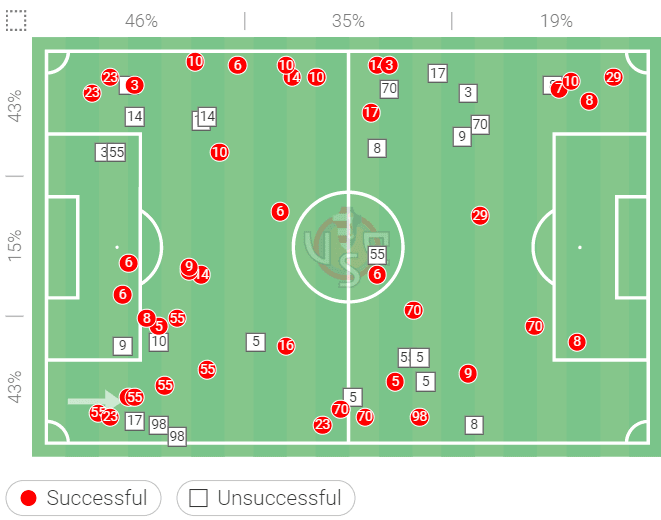
This data viz details all 68 of Cremonese’s defensive duels from a recent outing against Pordenone. 86 percent of their duels were in the halfspaces and wide areas with the rest coming through the central corridors.
During the low block phase, Cremonese drop their wingers back alongside the fullbacks. This allows the wide defenders to tuck in closer next to the centre-backs while the wingers are left to try and stop the crosses from coming into the box. Generally, this creates a 6-2-2 shape.
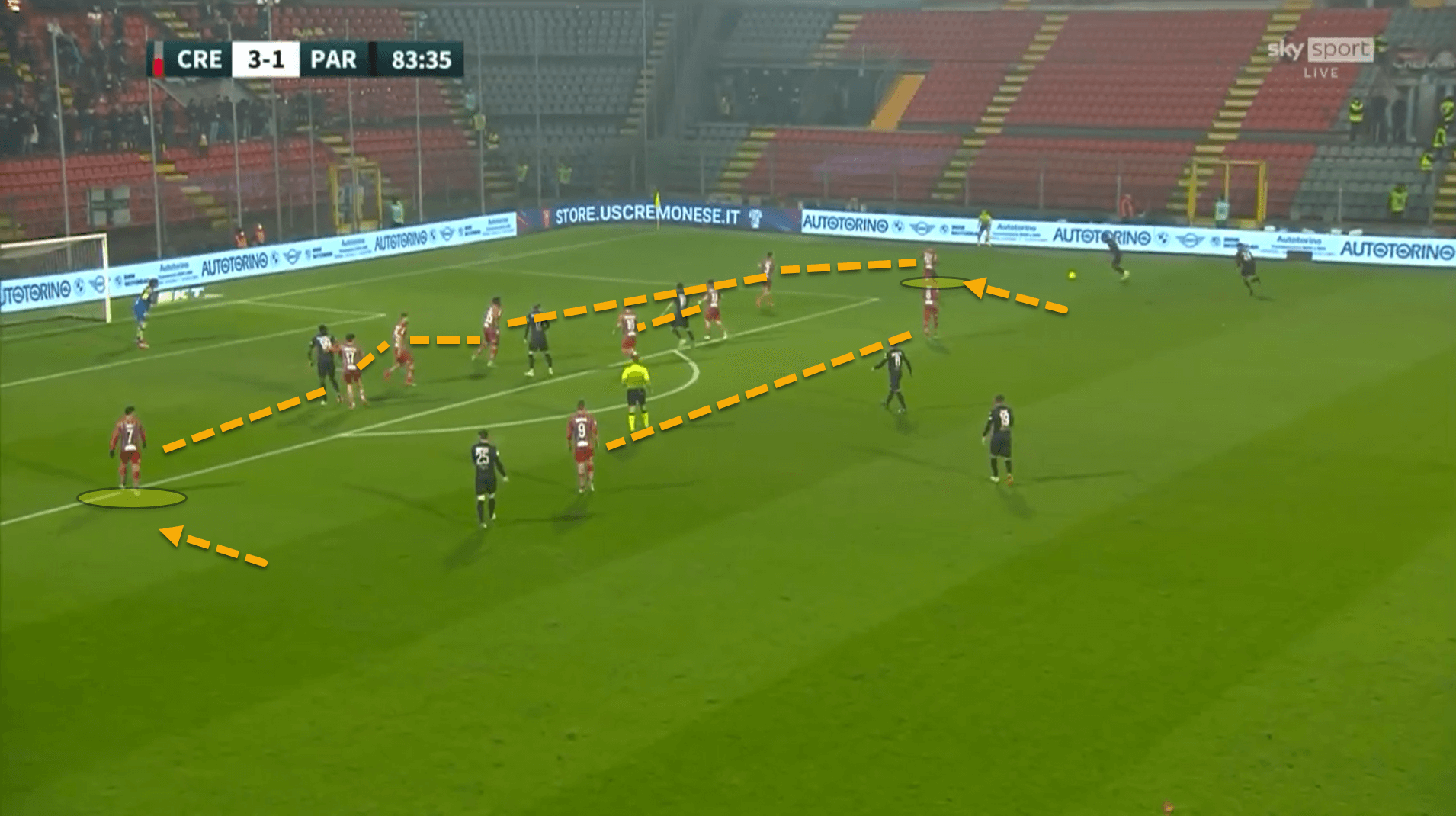
Conclusion
“It is not the most intellectual of the species that survives; it is not the strongest that survives; but the species that survives is the one that is able best to adapt and adjust to the changing environment in which it finds itself.” This infamous quote from the great naturalist and biologist Charles Darwin is poetically symbolic of Cremonese.
They do not possess the strongest squad in the league. They are certainly no footballing revolutionaries. They are not even the hardest working. However, there is a significant beauty in their ability to adapt to every game. Like an animal in the wild, this ability to adapt has helped them survive, but not just survive, it has rocketed them to the top of the food chain.






Comments